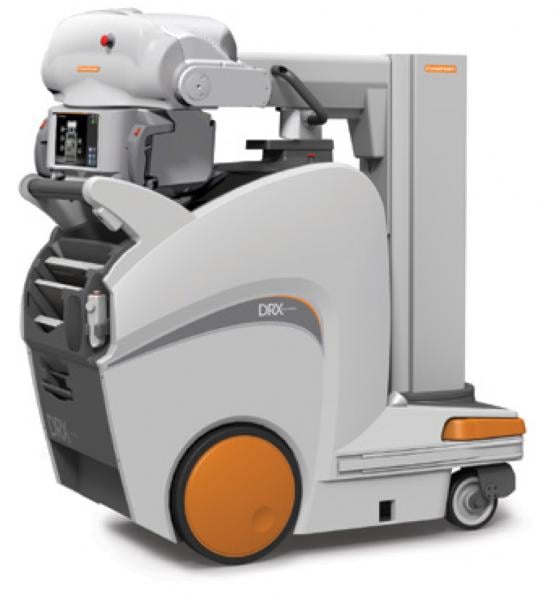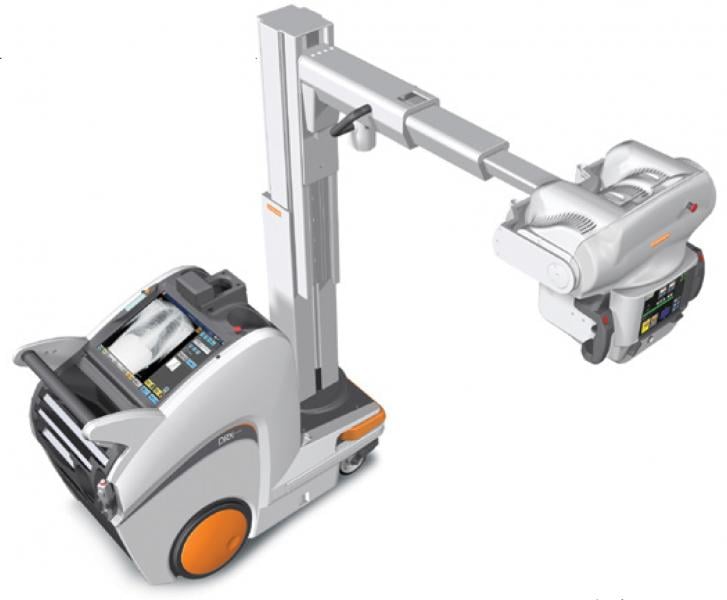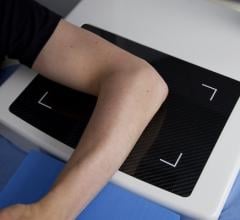
When OSF Saint Francis Medical Center in Peoria, Ill., was looking for a cost-effective way to upgrade its portable X-ray fleet, the facility considered a number of alternatives in its capital equipment search.
A large teaching hospital that performs about 125,000 diagnostic imaging procedures annually, St. Francis has a radiology department that includes a variety of imaging modalities.
By upgrading its CR-based portable X-ray devices, the department was searching for a way to bring a mature but much-needed imaging modality into the digital arena to improve throughput and efficiency, said Juanita Reader, Manager of Diagnostic Radiology In-Patient and Informatics.
“We wanted to go to a more digital environment but still be as cost-effective as possible,” Reader said.
The hospital considered several different vendors in its search, but ultimately selected Carestream Health of Rochester, N.Y., for its DRX mobile X-ray units. St. Francis purchased one DRX-Revolution Mobile X-ray as well as two retrofit kits that allowed insertion of DRX detectors into two of its older, analog, portable GE AMX 4 X-ray machines.
By inserting new DRX detectors into its existing inventory of equipment, St. Francis saved money over the cost of buying new systems, added new functionality to some of its workhorse devices, and helped improve its operations on a number of levels, Reader said.
“The DRX detectors that come with the DRX-Revolutions can be used in other imaging systems,” Reader said, “so if a detector is damaged or not working properly, or someone drops it, we can take another detector from any system and use it where it is most needed.”
Using DRX detectors also added other benefits, such as a 20-50 percent reduction in the dose of radiation to which patients are exposed during exams, Reader said. The wireless detectors communicate with the PACS, which means physicians and radiologists have instant access to images.
Additionally, when physicians order X-ray studies, the patients do not have to be moved because the portable devices allow the technologists to come to them, she said. Plus, the images captured are higher-resolution, which provides additional detail for orthopedic and spinal surgery cases, Reader said.
“Before computed radiography, we had regular analog film, and the film had to be taken out of the cassette, processed out of the machine, and then you had the piece of film,” Reader said. “The only way to get that into PACS was to digitize it, which was about a 30-minute process. With digital you’re probably at 15 seconds.”
Of the 3,700 portable X-ray exams performed monthly at St. Francis, about two-thirds of those are done with the Carestream portable units, Reader estimates. The quality of the images produced by the devices requires “very little tweaking,” she said, and the technologists enjoy operating the devices because they have advanced features.
For starters, Reader said, the units have “a very good HIPAA solution” built in, whereby a technologist swipes into the device with his or her identification badge, auto-populating login information.
“It prevents people from bypassing the step of identifying themselves or keeping people logged in and doing an exam under somebody else’s name,” Reader said. “It also helps eliminate misidentification of patients because you’re in the room, doing that patient, and you can send the image to the PACS system.”
Telescoping columns on the Carestream units allow shorter technologists to operate the devices effectively, she said. An image recall function allows the last patient exams to be brought back “so they know what technique was used previously,” Reader said.
Plus, since the device is wireless instead of tethered, “they don’t have to worry about cords and wires being run over” during transit, she said. Finally, the 32 KW generator on the DRX-Revolution is useful for larger bariatric patients, she said.
The Carestream units allow for greater workflow as well, Reader said, with staff “routinely” getting its morning ICU portable exams completed and sent to PACS before their daily 6 a.m. deadline. Prior to their installation, she said, “We were lucky to get 50 percent done by 6 a.m.”
“With only three digital portables, we want to make use of them ????????as much as possible,” Reader said. “We’ve probably cut the timeframe [for the capture and delivery of images] in half.”
She also pointed out that doctors in the hospital appreciate what the portable devices can do, and often will wait for one to become available “because they want that image,” she said.
“If they’re putting an NG [nasogastric] tube or a catheter, any type of line, especially in the ICU’s, they’ll be able to see if they need to make changes,” Reader said.
The value provided to the imaging department at St. Francis through the integration of the Carestream portable units also extends to staffing, Reader said.
“We predict the more portable [units] that we introduce that are digital, the more productive our staff will become.”
With the value demonstrated by the Carestream retrofit packages, Reader said her department is hoping to convert two more systems from CR to DR in the next procurement cycle. That is equivalent to the price of a single, new portable digital unit, she said.
“Image quality, consistency, patient safety, radiation dose, we’re getting the same value and the same performance from the retrofitted systems that we are from the new DR systems,” Reader said.
“They’re very economical for the amount of portables that we have.”
Reader foresees the departmental fleet of 12 portable units reducing to about seven of the retrofitted models, which will allow it to retire units that are 15 to 20 years old.
“They have been rebuilt; they have seen some hard work as far as portables go,” she said. “A couple of them we will be able to pass on to sister hospitals that don’t do the volume that we do, and by not having to replace, we’re saving money there too.”




 December 10, 2025
December 10, 2025 









